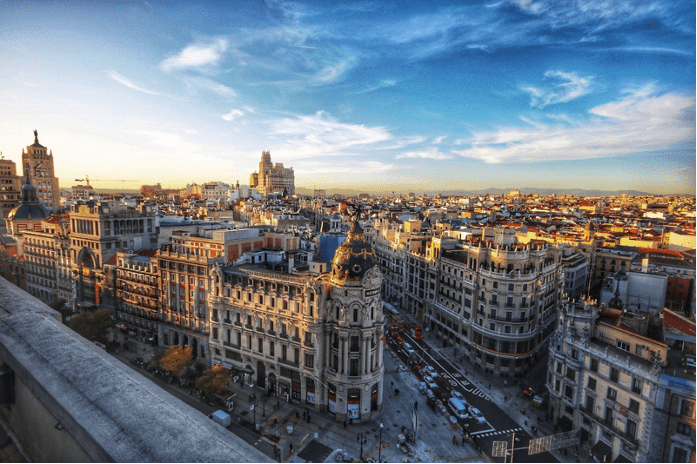Why I Chose to Study Sustainability in Spain
¡Hello everyone! ¡Bienvenido a Madrid! My name is Maddie, and I am so excited to spend the next semester with you all, learning about Spain and some of the environmental issues that are present there. However, before we dive into that, let me explain a little bit more about how I ended up here in the first place.
Being a Spanish Language & Culture major at Amherst, I always knew that I wanted to study abroad at some point during my college career, specifically in a Spanish-speaking country. In fact, I was hoping to go for an entire year, in two different countries no less! Unfortunately, the onset of the pandemic definitely made that process much more challenging, and there was a point in time when I questioned whether I would ever be able to study outside of the United States again. But, once it became clear that foreign countries were once again accepting U.S. students, I knew that my schedule was back on track.
I ended up deciding to study abroad in Spain because, with the exception of Ireland, I’ve never been to Europe. There have always been too many obstacles preventing me from visiting—the cost, accommodations, time, school, etc.—so I haven’t had the chance. Studying in Spain seemed like the perfect opportunity for me to finally increase my Spanish fluency while also being able to seemlessly travel around Europe.
Furthermore, I opted to live in Madrid, specifically, for a variety of reasons. First of all, unlike Amherst, it’s a large, metropolitan city. Although I love the ruralness of Western Massachusetts, I do miss being able to spend nights out on the town, and I wanted to have that experience while abroad. Secondly, unlike Barcelona, Catalán is not as widely spoken. Given that I was going to Spain to learn Spanish, I figured that being in a city where another language was also spoken would be quite difficult. Lastly, Madrid has some of the most amazing architecture, history, and museums. I cannot wait to spend hours in the Museo Nacional del Prado, explore the Real Jardín Botanico with my host family, and finally visit the world-famous Edificio Metrópolis.

I’m also incredibly excited to learn more about the sustainability efforts in Madrid with you all, specifically how the city handles issues of air pollution. Historically, the capital city has fared poorly in comparison to other Spanish urban hubs with regards to its air quality. Though that may be due to its large population of approximately 3.2 million people, it still doesn’t negate the fact that these levels of air pollution lead to real health consequences, such as respiratory illnesses, cardiovascular diseases, and premature deaths.
To provide you all with some context, the World Health Organization (WHO) recommends that the city try to keep their fine particulate matter at around 10 µg/m3 each year. In 2019, Madrid exceeded this number within a span of three months, mainly due to traffic pollution. Spain, itself, has actually been publicly reprimanded by the European Commission for not complying with their air quality standards.
Interestingly enough, as far as global capitals are concerned, Madrid actually ranks relatively low for air pollution. In 2021, the World Quality Air Report found that of the 107 captial cities they examined for finite air particulates, Madrid ranked number 84th with a µg/m3 number of 9.4, meaning that its air quality is clean in comparison with other cities.

My hope is that, with this blog, we will all be able to delve more deeply into the history of Madrid’s air pollution, how it connects to traffic regulation, and its relationships to modern-day global warming/climate change. Having never been to Madrid before, I’m unfamiliar with most of the cities sustainability efforts. I know about some of their broader initiatives, such as restricting traffic and implementing various climate action plans, but I hope to understand them further. Additionally, in light of the horrible fires that have been ravaging the Spanish countrysides, I want to see how the country’s weather and increasingly frequent heat waves also connect to its problems with air pollution, as I am sure there is a link.

I definitely have my work cut out for me, but it’s work that I cannot wait to start. As a young global citizen of this world, it’s about time that I did some research into other countries’ methods of sustainability—their trials, tribulations, successes, failures, the whole nine yards. In order to make our earth a better and safer place, we need to research what our peers have done and learn from their mistakes. As the famous American general George S. Patton once said, “Prepare for the unknown by studying how others in the past have coped with the unforeseeable and the unpredictable.” And, this semester, I plan to do just that.
Alright, signing off! ¡Muchas gracias por su atención, y le contactaré pronto!
- Madrid Air Quality Index (AQI) and Spain Air Pollution | IQAir. (2022). Retrieved 1 August 2022, from https://www.iqair.com/us/spain/madrid
- ^^
- ^^
- World’s Most Polluted Cities in 2021 – PM2.5 Ranking | IQAir. (2022). Retrieved 1 August 2022, from https://www.iqair.com/world-most-polluted-cities
- Madrid Air Quality Index (AQI) and Spain Air Pollution | IQAir. (2022). Retrieved 1 August 2022, from https://www.iqair.com/us/spain/madrid